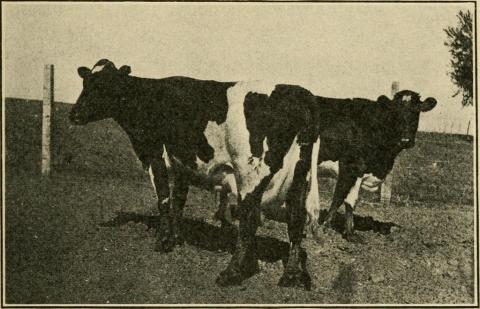
The following is a "poem" about the future of dairy farm size and ownership structure in the UK and Ireland. It's comprised of direct quotes from interviews with key stakeholders and document analysis in both countries. You can read more details about the data collection at the end. The country of the interviewee is given after each quote. It's intended to show the range of different views people expressed about farm size and farm structure.
Expansion has gone phenomenally well. (Ireland)
It’s coming, it’s here. It’s here, and it’s not nice. It’s not nice to see… it’s not nice to see small being pushed out. I don’t like it. And I think, where, because right now, we are using them to support our marketing, you know, we do take pictures of the family together and, you know, and, the, the child feeding the calves, and you know, they all, as a unit, standing by the parlour. (Ireland)
Yeah, like, we, we, there’s an old saying here, profit is sanity, you know, milk yield is vanity. And, it is true. They go down to the pub at night, they’re talking milk yield. You know.……What does that mean? (Ireland)
So it’s always challenging, isn’t it, because everybody, ultimately, will view success, our farmers will view success as their ability to produce more litres and have more cows. (Ireland)
A long tradition of farming at world market prices has built up a very clear business ethic in the dairy farming sector in NZ which is not fully mirrored in Ireland which still bears a lot of hallmarks of family farming type operations. (O’Donoghue et al., 2015)
No one is born with a right to do anything. It’s got to work in a market place, hasn’t it? The dairy industry can’t be a charity case. It’s got to be efficient and proper to make it, at the end of the day. (UK)
Once dairy farmers have maximised their efficiency for any given scale of production, they need the opportunity to expand their businesses to continue to improve efficiency through achieving economies of scale by spreading fixed costs over a larger scale of production. This means that there is a strong correlation between farm size and efficiency. (Dairy UK, 2017)
All the, you know, all the fixed costs aren’t diluted, so this is the other fucking thing that bugs me around the high input, you know, apparently, the more milk you produce, you dilute all the fixed costs. (Ireland)
and, but I have this little shudder in my bones, thinking that that’s the way it’s going. (Ireland)
What would my dairy farm look like? It would be a lot bigger than it was. It would, and we ceased, we stopped production because of, it just wasn’t viable for the size of farm, so it would be a lot bigger today than it was. (UK)
Big can be really, really good. (UK)
You shouldn’t be embarrassed about having thirty cows. (Ireland)
There was a local young farmer here and he was being hailed for increasing his herd size and he was being praised. He’s ended up with real mental health problems. He got too many loans he couldn’t afford to pay back and he couldn’t afford to feed his animals. His business has gone to pot. There’s too much pressure on the farmers. (Ireland)
We haven’t moved away from family farms yet but I think it’s a question of time. (Ireland)
There's a hell of lot of – less…herd owners that are female than there are male and I think that's another aspect of it, so whether it's male or female, whoever wants the farm should be able to get into it. (Ireland)
But, you know, staying as you are, eventually, you’re going to get left behind. (Ireland)
However, developers argue that larger facilities will create employment opportunities, albeit of a different nature to those found on a small, traditional, family run farm. (POST, 2012)
DAFM (2010) Food Harvest Food Harvest 2020: A vision for Irish agro-food and fisherie. Department of Agriculture, Fisheries and Food. Dublin. Available at: https://www.agriculture.gov.ie/media/migration/foodindustrydevelopmenttr...
Dairy UK (2017) The white paper. London.
O’Donoghue C, Creamer R, Crosson P, et al. (2015) Drivers of agricultural land use change in Ireland to 2025.
POST (2012) Livestock Super Farms. POSTnote. London. Available at: https://www.parliament.uk/documents/post/postpn404_livestock_super_farms...
Interviews were carried out between September 2018 and Feburary 2019 with 19 key stakeholders in the dairy industry in Ireland and 25 in the UK from industry, government, academia and non-governmental organisations. 26 Irish documents were analysed and 38 UK documents.